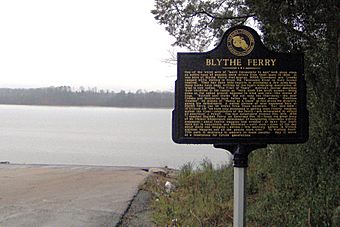Blythe Ferry facts for kids
Quick facts for kids |
|
|
Blythe Ferry
|
|

Blythe Ferry site
|
|
| Location | North of Birchwood on S.R. 60 at Tennessee River |
|---|---|
| Built | 1809 |
| Architect | William Blythe |
| MPS | Meigs County, Tennessee MRA |
| NRHP reference No. | 83003055 |
| Added to NRHP | January 5, 1983 |
Blythe Ferry was a special crossing point over the Tennessee River in Meigs County, Tennessee. It became very important in 1838 during a sad time known as the Trail of Tears. This was when thousands of Cherokee people were forced to leave their homes in the southeastern United States and move far away to Oklahoma.
Even though the ferry no longer operates, the place where it used to be is now part of the Cherokee Removal Memorial Park. This park was opened in 2005. It is also part of the Hiwassee Wildlife Refuge, which is looked after by the Tennessee Wildlife Resources Agency.
Contents
Where Was Blythe Ferry Located?
The Blythe Ferry site is on the eastern side of Chickamauga Lake. This lake is part of the Tennessee River. It's just south of where the Hiwassee River flows into the Tennessee River.
The site is located near where three counties meet: Meigs County, Rhea County, and Hamilton County. Tennessee State Route 60 used to cross the river at the ferry. This road connects the area to Cleveland to the east and Dayton to the west. The small town of Birchwood is also nearby.
The History of Blythe Ferry
How Blythe Ferry Started
Blythe Ferry was started around 1809 by a man named William Blythe and his Cherokee wife, Nancy Fields. The ferry was a very important way to cross the river on a major road. This road connected the cities of Chattanooga and Knoxville.
William Blythe sold the ferry in 1825. Later, in the 1830s, the Blythe family also moved west with the Cherokee people.
The Trail of Tears Connection
In 1836, a document called the Treaty of New Echota was agreed upon. This treaty said that all Cherokee lands east of the Mississippi River would now belong to the United States. The treaty also planned for the Cherokee Nation to move to what was called the Indian Territory (which is now Oklahoma).
By 1838, President Martin Van Buren ordered General Winfield Scott to make sure all Cherokees who had not moved willingly were gathered. They were then forced to move. By the fall of that year, about 9,000 Cherokee people and 300 Creek people were gathered in temporary holding areas. These areas were in Bradley County, a few miles east of the ferry.
It took several weeks to move all these people across the river at Blythe Ferry. The very last group crossed on November 12, 1838. This difficult journey is remembered as the Trail of Tears.
The Ferry's Later Years
Blythe Ferry continued to operate as part of Tennessee State Route 60. It kept running until 1994. In that year, a new bridge was built just downstream from the ferry site. This bridge made it easier and faster to cross the river.
The ferry site itself was recognized for its historical importance in 1982. It was added to the National Register of Historic Places.

